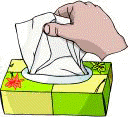BACKGROUND:
The human body has five major senses which operate to
gather information from the world around us, sight, hearing, smell, taste,
and touch. Any stimulus to one of the sense areas is detected by
sensory nerves and is sent to the brain for interpretation.
The eye (an organ) acts like a camera. Human vision is stereoscopic,
which means seeing in three dimensions. When we look at objects, two
slightly different images are transmitted to the brain, and are merged so
the brain can interpret the image that we see. This allows us to see
objects which stand away from the background, not flat like you see in a
photograph.
The ear (an organ) is specially made to receive sound waves that are sent
out by vibrating objects and converts them into sensations we call sound.
The nose contains the nostrils and organs of smell. The stimulus that
excites smell is chemical, for example onion and garlic give off different
chemical sensations.
The tongue is the organ that controls taste. Taste is also a chemical
stimulus. Things to be tasted must touch the tongue, sometimes, taste
become combined with smell because of the connection between the mouth and
the back of the nose.
Touch is created by stimulating the skin (the largest organ of the body)
through the sensations of touch, pressure, pain, heats and cold.
Discussing senses and actually having the children experience the different
senses requires selecting items that will "accent" the sensation
of that sense. For instance, the sense of touch is much more exciting
if the item being touched cannot be seen and feels "gooey."
If you eliminate some of the other senses and have the children rely just on
one sense, the sensation is much more acute.
PROCEDURE:
Now that the students
have learned about senses, let them use their newfound knowledge to explore
items. You can do this in several ways, depending on the availability
of materials and the help you get from parents.
- One way is to make "feely"
boxes. Put items in a box that the students cannot see what the item
is. Try to get
 objects that have an unusual feel. Use a box
with a hole cut in the side or use an empty tissue box and have the students
figure out what they are touching. Have the students describe
the texture. It is more important to have the students use their
senses than identify the object. (When you finish with the materials,
put them back into their appropriate box. Students will want to play with
the items if you leave them out.) Students are using the sense of
touch and eliminating the sense of sight. On some of the items you
might have the students shake the box to use the sense of sound. objects that have an unusual feel. Use a box
with a hole cut in the side or use an empty tissue box and have the students
figure out what they are touching. Have the students describe
the texture. It is more important to have the students use their
senses than identify the object. (When you finish with the materials,
put them back into their appropriate box. Students will want to play with
the items if you leave them out.) Students are using the sense of
touch and eliminating the sense of sight. On some of the items you
might have the students shake the box to use the sense of sound.
- You can blind fold your
students and give them samples of fruit to see if they can determine what
the fruit is (sense of taste). While they are blind folded,
bottles of perfume or flavoring can test the sense of smell.
- If you have enough
help, you can divide the students into small groups and discuss the following
activities. For instance, one station might have different smells,
for example vanilla, perfume, oil, or any other smells you would like to
introduce. Ask students to pick the smell that reminds them of cookies
(vanilla) or the one that reminds them of flowers (rose perfume).
At another station, cut up pieces of oranges, apples, bananas, lemons,
or any other fruit. Have students close their eyes and ask them which
one tastes sour (lemon).
|